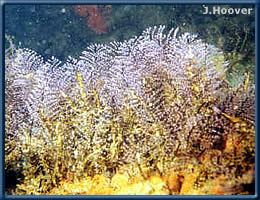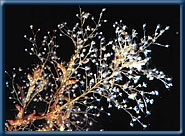

Phyllorhiza punctata

Cassiopea andromeda

Pennaria disticha

Carijoa riisei

Diadumene lineata
Pennaria disticha
 Christmas
tree hydroid
Christmas
tree hydroid
Phylum Cnidaria
Class Hydrozoa
Order Hydroida
Family Halocordylidae
Description
Colonies are large, as tall as 30 cm, with a dark brown to black perisarc,
a protein-chitin exoskeleton which surrounds the stem and branches. This
perisarc is usually overgrown with diatoms and algae, making the branches
of the hydroid appear muddy brown. Branching is alternate. The polyp has
a circle of 10 to 18 filiform tentacles at the base and as many as 12
capitate tentacles on the upper part of the hydranth. The polyps are white
with a reddish tinge. Annulations occur on the branches which bear the
polyps, and on the main stem and side branches.
Habitat
 Attached
to artificial and natural hard substrates where there is some water movement.
Very common as fouling in harbors throughout the main islands, and commonly
found on reefs usually in more protected areas or in cracks and crevices.
Attached
to artificial and natural hard substrates where there is some water movement.
Very common as fouling in harbors throughout the main islands, and commonly
found on reefs usually in more protected areas or in cracks and crevices.
Distribution
Hawaiian Islands
All main Hawaiian Islands
Native Range
Western Atlantic
Present Distribution
World-wide in warm seas
Mechanism of Introduction
Unintentional, as fouling on ships' hull
Impact
Fouling organism. Ecological impact unstudied, but some competition for
space with other invertebrates likely. This hydroid will sting humans,
causing a mild irritation.
Ecology
Feeding
The hydroid is a carnivore, using the stinging cells in its tentacles
to capture small plankton which drifts by in the currents. The feeding
tentacles carry the prey to the mouth region where it is ingested whole.
Reproduction
Hydrozoan polyps can reproduce asexually by budding. The medusa (gonophores)
bud off singly from the hydranth body just above the proximal tentacles.
A single colony bears gonophores of one sex only. The mature medusae are
similar in the two sexes; they have an elongate bell, a velum, four radial
canals and four rudimentary tentacles. Pennaria
medusae generally break away from the colony and swim about during the
discharge of the sex products, but depending on environmental conditions,
they may remain attached. At the onset of spawning, the ripe medusae gradually
begin a rhythmic twitching. The males emit puffs of white sperm, the females
eject three to six eggs. The spent medusae finally drop off, swim feebly
if at all, and shrivel and die in a few hours.
Fertilization is external. In about a day, developing embryo becomes a
young free-swimming planula, which will eventually settle and develop
into a young hydroid colony.
Remarks
We regard this common fouling hydroid as introduced with ship fouling.
It is reported, with various synonyms, from warm-water seas worldwide.
Edmondson (1933) reported it (as Pennaria tiarella)
in Pearl Harbor and Kaneohe Bay, attached to stones, pilings of old wharves,
buoys, and other floats. He noted that it appeared to be identical to
the Atlantic Ocean P. tiarella McCrady, and
may have been transported to Hawaii on the bottoms of ships.
Boone (1938) redescribed P. disticha as a
new species, Corydendrium splendidum, from
Kaneohe Bay (later synonymized by Cooke, 1977), collected as a single
large colony in 2 meters of water at low tide, in 1928. It has been widely
reported by numerous authors throughout the main Hawaiian islands.
References
Boone, L. 1938. Family Clavidae. Bull. Vand. Mar. Mus. 7: 33-34.
Cooke, W.J. 1977. Order Hydroida. in: Devaney, D.M and L.G. Eldredge,
Reef and Shore Fauna of Hawaii, Section 1:Protozoa through Ctenophora.
Bishop Mus. Spec. Pub. 64(10): 71-104.
Edmondson, C.H. 1933. Reef and Shore Fauna of Hawaii, Bishop Museum, Spec.
Pub. 22.
© 2002 Hawaii Biological Survey, Bishop Museum
contact